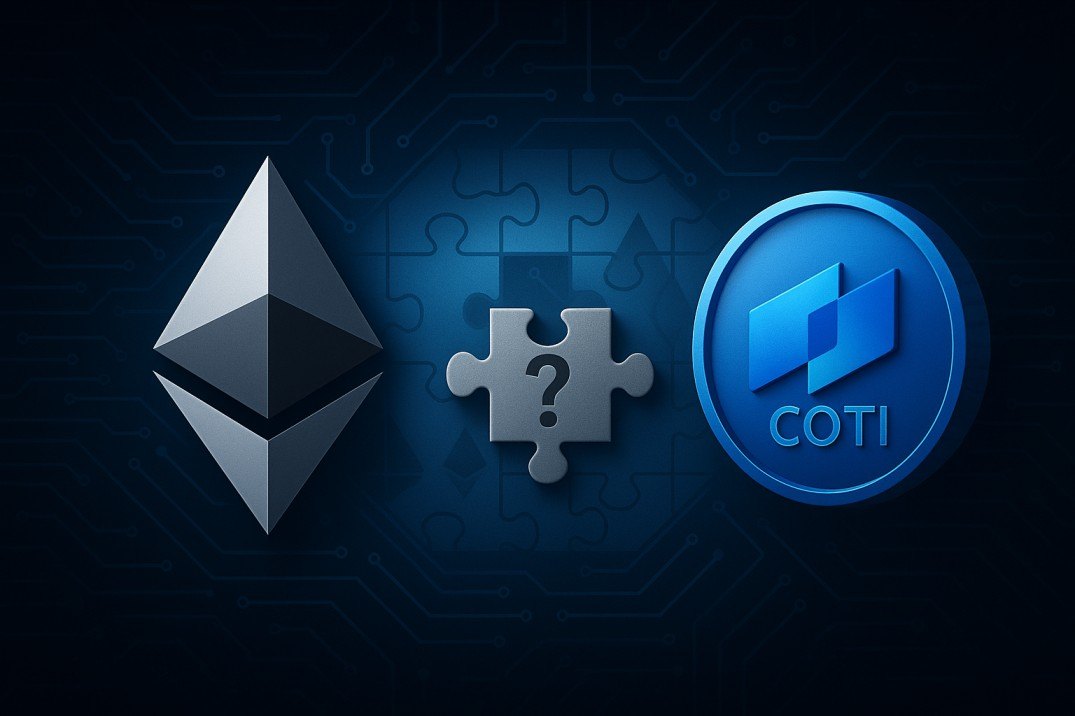TL;DR
- Ethereum, by design, is transparent: every transaction, smart contract call, and balance is public. This openness has underpinned trust - but it also opens the door to surveillance, analytics, front-running, and privacy risks.
- The Ethereum Foundation recently rebranded its privacy research effort as Privacy Stewards of Ethereum (PSE) with a roadmap that targets private writes, private reads, and private proving.
- But Ethereum's privacy enhancements remain in early stages and are opt-in in many cases. Meanwhile, many sectors-from finance to health to institutions-are demanding privacy today.
- COTI, as a privacy-first L2 powered by garbled circuits, positions itself as a practical and performant solution. Its V2 mainnet is live, offering "Privacy-on-Demand," EVM compatibility, and confidential smart contracts.
- Because COTI already has working privacy infrastructure (and real deployments in institutional settings), it may well fill the gap while Ethereum continues to mature.
- In short: COTI doesn't replace Ethereum; it complements it - becoming a privacy layer that Ethereum-native teams may adopt for confidentiality, not just scalability.
Privacy used to be optional. Now, it’s essential. From retail users to global banks, everyone’s waking up to the same realization that blockchains reveal too much. Every token transfer, every contract interaction, every address tie back to a digital fingerprint that never fades. What began as transparency for trust has slowly turned into a glass box where no one can move without being watched.
Ethereum, the world’s most used smart contract platform, sits at the heart of this dilemma. It powers billions in DeFi and NFT activity, yet everything remains public by default. Wallet balances can be traced, trades analyzed, even voting behavior on DAOs tracked. Over time, this transparency has eroded one of the things users value most - control over their own data. That tension has now reached a breaking point. Institutions entering the space, banks, payment firms, and even governments can’t operate without confidentiality. Individuals, too, are demanding privacy as a right, not a feature. And Ethereum’s developers know it. After years of experiments, the Ethereum Foundation is finally pushing a coordinated privacy roadmap called Privacy Stewards of Ethereum (PSE) , aiming to weave encryption and confidentiality into the core of the network.
But building privacy into Ethereum isn’t easy. It requires new cryptography, new infrastructure, and years of iteration. In the meantime, another player has quietly built a solution that’s already live- COTI, a Layer 2 network powered by garbled circuits, a cryptographic method once thought too complex for real-world use. COTI’s approach is simple but profound: it enables “Privacy-on-Demand”, letting users and developers choose when to keep transactions, logic, or data confidential, without breaking Ethereum compatibility. While Ethereum’s privacy effort is still forming, COTI has already turned theory into action, even working alongside major financial institutions exploring confidential CBDCs.
In many ways, COTI might be what Ethereum has been missing all along, a scalable privacy layer ready today, not tomorrow.
Ethereum's Move Toward Native Privacy
Recognizing this gap, the Ethereum ecosystem is now taking formal steps to embed privacy rather than treat it as an add-on. The research arm formerly known as Privacy & Scaling Explorations has been rebranded as Privacy Stewards of Ethereum (PSE).
The new roadmap outlines three major pillars:
- Private writes: Enabling confidential transactions, transfers, DeFi operations, voting, etc.
- Private reads: Preventing metadata leaks when users interact via RPCs or query chain state.
- Private proving: Making zero-knowledge proof generation lightweight and widely accessible, enabling proof-of-privacy capabilities even on everyday devices.
Ethereum's founding figures are vocal about this shift. Vitalik Buterin recently articulated a privacy vision that includes integrating privacy tools into wallets (e.g. shielded balances, "send from shielded"), and defaulting to privacy features so users don't have to opt in manually.
Still, these enhancements are early-stage. Many of the privacy features must work with cross-layer tooling, new cryptographic primitives, and coordination across clients, rollups, and application teams. For now, much of it remains optional, experimental, or domain-specific. Ethereum's privacy ambitions mark a turning point. But they may take years to fully mature - leaving a window for complementary solutions to act now.
Where COTI Fits In: The Privacy Puzzle Piece Ethereum Needs

COTI's design is tailored precisely for this moment. It doesn't seek to overshadow Ethereum; rather, it aims to slot in as a privacy layer, offering confidentiality and private logic while remaining EVM-compatible and composable with Ethereum-native applications.
COTI V2 Mainnet and Garbled Circuits
In March 2025, COTI launched its V2 mainnet, transitioning to an EVM-compatible privacy-focused Layer 2. The core technology is Garbled Circuits, a cryptographic approach that enables computation on encrypted data without revealing the inputs - a strong tool for execution confidentiality.
COTI claims its implementation is fast - up to 3,000× faster than competing solutions under certain benchmarks - and capable of handling 1,000 TPS native and 40 TPS for encrypted transactions. Because garbled circuits can handle general-purpose logic (not just specialized proofs), they can support private smart contracts, not just private transfers.
Privacy-On-Demand: A Layer That Complements Ethereum
COTI promotes "Privacy-on-Demand": users or applications can opt in to confidential operations only when needed, rather than being forced into it. That flexibility is key, especially for Ethereum, where many protocols may still rely on standard transparency for interoperability, analytics, or cross-chain bridging. Because COTI is EVM-compatible, existing Ethereum teams can port or integrate functionality without rewriting from scratch. This lowers the barrier for Ethereum-native protocols to adopt confidentiality.
Institutional and Real-World Deployments
COTI is not purely theoretical. It is already engaging with real institutional use cases - from European Central Bank CBDC pilots to participation in Israel's digital Shekel experiments - positioning its privacy infrastructure as a serious option for regulated deployments.
Moreover, COTI's roadmap includes confidential stablecoin flows (e.g. "Private DJED") and multi-chain interoperability of privacy contracts. In doing so, COTI provides a bridge: Ethereum protocols get confidentiality, institutions get privacy and compliance, and users gain protection - while preserving composability with Ethereum's ecosystem.
Technical Strengths & Trade-offs

COTI's advantages derive from a combination of tech design and pragmatism. But it's not without trade-offs.
Strengths
1. General-purpose privacy for logic, not just payments
Garbled circuits allow you to build private smart contracts - not only private transactions.
2. Performance & efficiency
Because COTI's GC implementation is optimized and lightweight, many operations are claimed to be faster than zero-knowledge or FHE-based alternatives.
3. EVM compatibility and composability
Developers can deploy or adapt existing Ethereum smart contracts with less friction, while gaining confidentiality.
4. Privacy-on-demand
Confidential operations can be used selectively - you don't sacrifice transparency everywhere.
5. Institutional readiness
With real-world pilots and CBDC interest, COTI positions itself beyond experiments.
Trade-offs & open challenges
Complex circuits and cost
Garbled circuits scale less smoothly for extremely complex logic compared to highly optimized zk systems.
Adversarial security
Ensuring resistance to malicious parties (not just semi-honest ones) adds extra overhead and verification logic.
Adoption inertia
Ethereum protocols, users, and tooling must adopt COTI or integrate confidentiality - that migration takes time and trust.
Cross-layer coordination
Privacy must integrate with scaling, bridging, layer-2 rollups, and oracle systems - which complicates architecture.
Regulatory scrutiny
Confidential systems face higher regulatory attention especially for misuse, money laundering, or surveillance avoidance. Yet these are not blockers; they are challenges that any privacy-first infrastructure must tackle. COTI's early deployment gives it a head start.
Why COTI's Timing May Be Perfect
Ethereum's privacy roadmap is real and promising. But it is also long-term and gradual. Many features must be designed, tested, optimized, integrated across clients and rollups. For years, many projects will need privacy but cannot wait.
COTI enters precisely in this gap: offering working confidentiality today, with performance, compatibility, and composability. As Ethereum advances, COTI may evolve in tandem, becoming the modular privacy layer many protocols rely on. To put it another way: COTI isn't competing with Ethereum. It's enhancing it. Ethereum must integrate privacy into its core to remain a general-purpose, trust-minimized backbone. But until that is fully in place, COTI can be the "privacy puzzle piece" Ethereum-native projects turn to, without rewriting their logic or leaving the EVM ecosystem.
Final Thought
Public blockchains are powerful precisely because they are transparent. That transparency built trust and auditability. But as blockchain becomes more practical - handling real assets, real identity, and enterprise logic - transparency becomes a liability.
Ethereum now recognizes this. Its privacy roadmap under Privacy Stewards of Ethereum is a bold, essential move toward embedding confidentiality at all layers. Still, theory and roadmap take time. Meanwhile, COTI is already walking the walk: building an EVM-compatible privacy L2 powered by garbled circuits, engaging with institutional use cases, and supporting confidential smart contracts. COTI isn't a speculative promise - it's a working reality.











